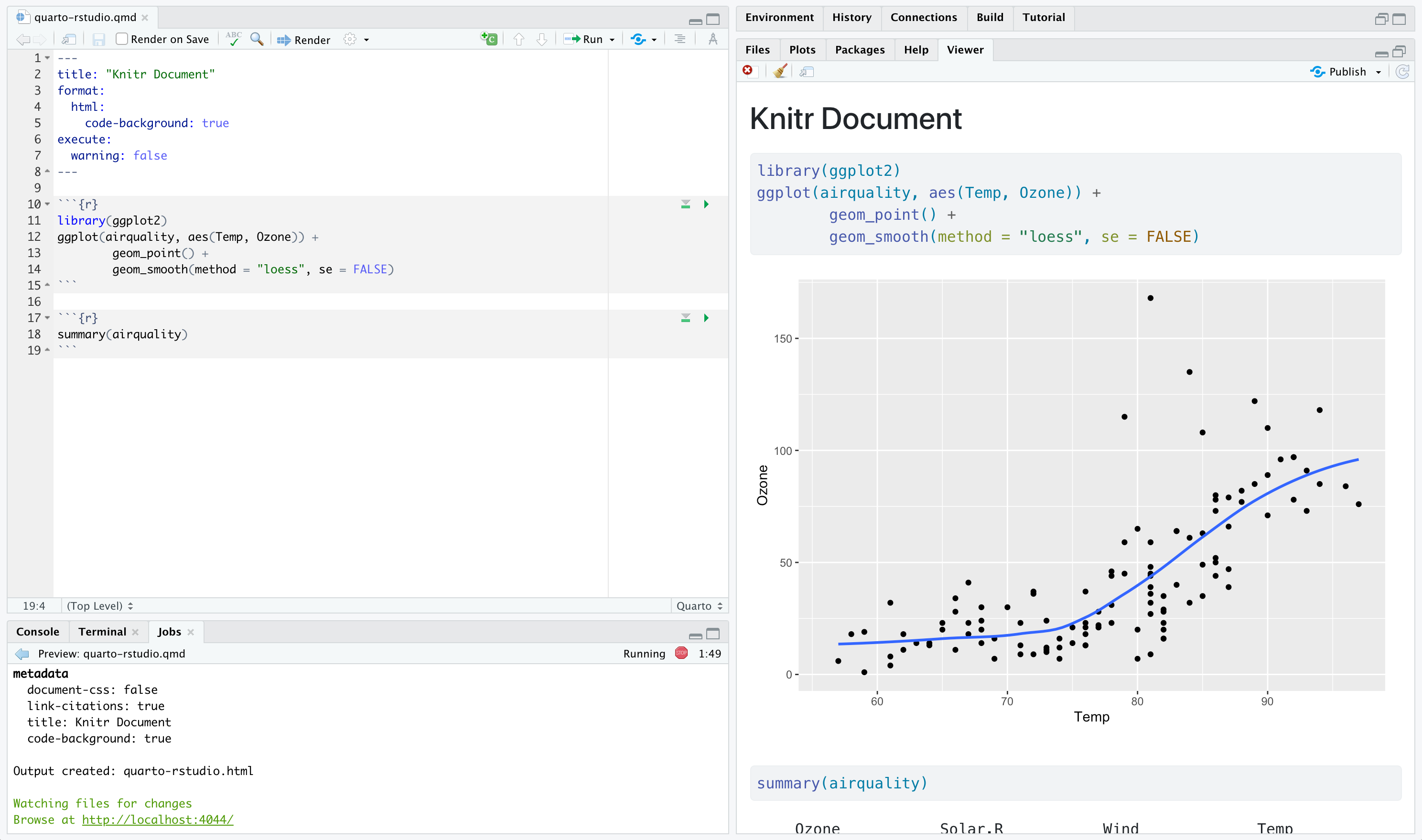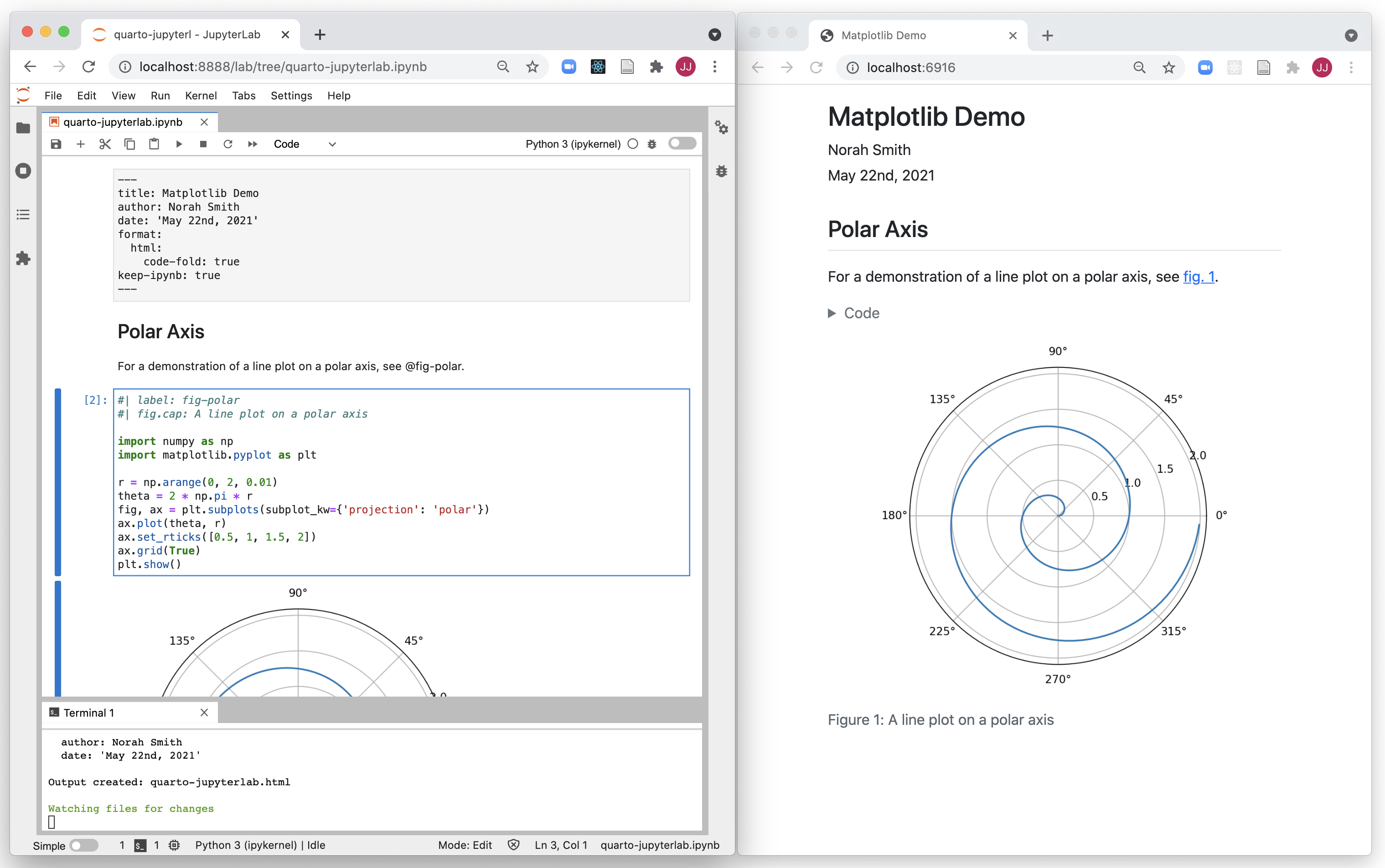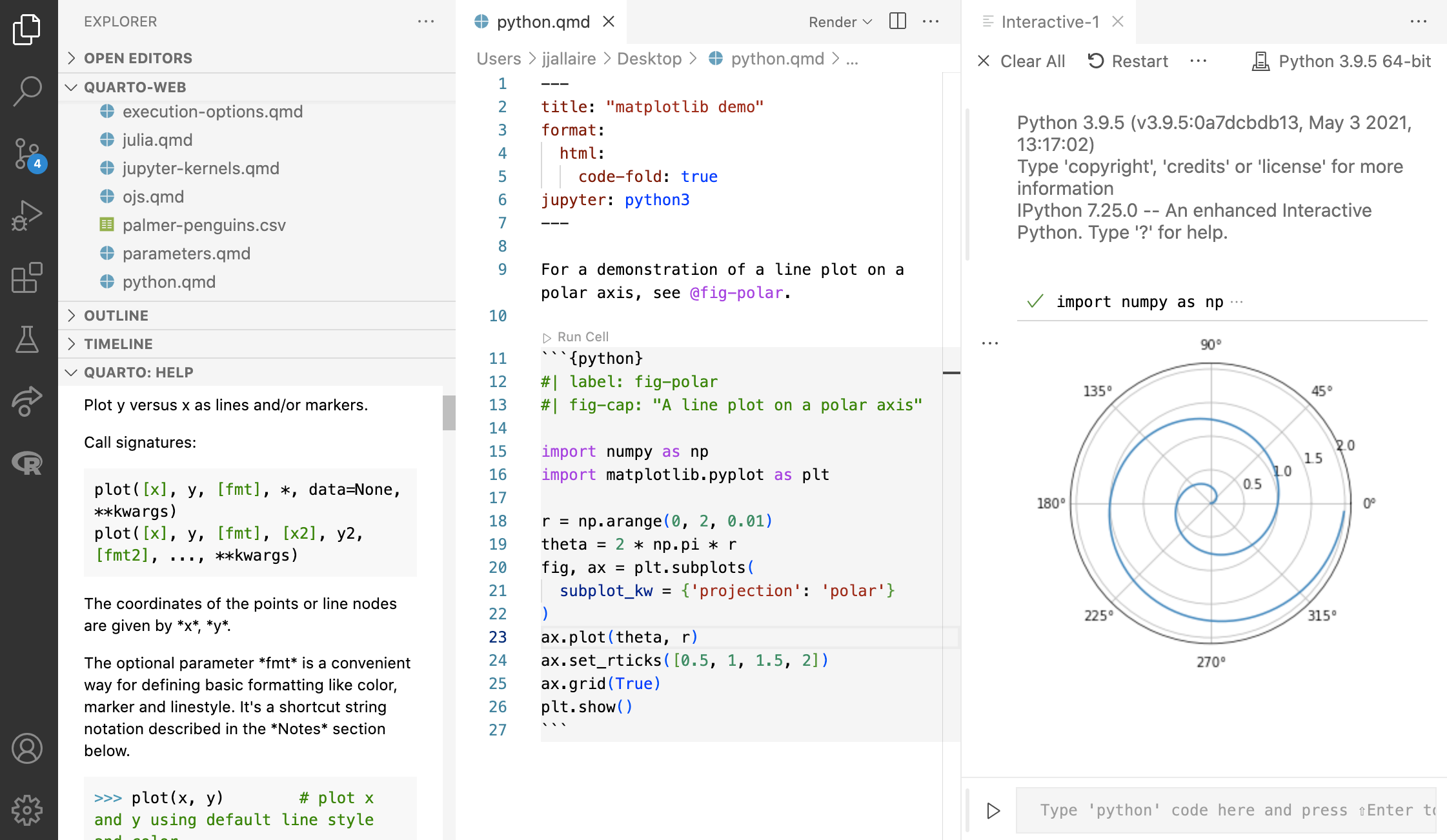library(leaflet)
leaflet() %>%
addTiles() %>% # Add default OpenStreetMap map tiles
addMarkers(lat=54.9734625, lng=-1.6242486, popup="RSECon 2022")Quarto:
A library to run them all?
RSE Conference 2022 | Newcastle Upon Tyne
Carlos Cámara-Menoyo | Cagatay Turkay | James Tripp
Centre for Interdisciplinary Methodologies (University of Warwick) | IT Services (University of Warwick)
Goals
- Introduce Quarto
- Facilitate you working with Quarto
- Have a discussion evaluating Quarto
Plan
- Introductions
- Introduction to Quarto
- Use cases
- Group formation and cases
- Working in groups - with break!
- Large group Discussion
- Farewell
Introductions
Let’s get to know each other
About us

Carlos Cámara
Research Software Engineer
- R user
- Interested in reproducibility, open science, geospatial data, visualisation

Cagatay Turkay
Professor
- Python user
- Interested in visualisation and data science

James Tripp
Research Software Engineer
- Python, R and PHP user
- Interested in research software engineering, data science and digital humanities
About you
Let us know about your prior knowledge about quarto
- Experts
- Some degree of knowledge
- Never used before, but I know what it is
- I do not know what it is
About your preferred programming language:
- R | Python | Julia
About this workshop: Have you had time to read cases’ descriptions?
Disclaimer
About us
We are not Quarto experts!
We are not affiliated in any way to Quarto or Posit. We do not have any commercial interest.
We are just quarto users who want to share our progress and engage with other users in a co-creation process with an attitude of healthy skepticism.
About the session
This is not (just) a talk about quarto. Others have done it very well before1. We will be presenting quarto’s main claims and putting them to a test (with your help).
About the slides
These slides have been created with quarto (of course!)
Quarto
A brief overview to quarto
(that’s why we are here, right?)
Preamble
- Agreement on importance of Literate programming (concept) and notebooks (artifacts)
- Lots of different solutions, mostly language specific
R: Rmarkdown
- Markdown with configurable code blocks
- Focus on R (but does support other languages see here)
- Can compile to other formats:
- natively
- bookdown, blogdown, …
Python: Jupyter notebook
- Single
JSONfile containing code, text and output - Kernels for many programming languages
- Can compile to other formats:
- Jupyter book, nbconvert, …
This might be about to change with quarto
What’s quarto?
According to their creators1 (Posit -formerly RStudio)):
- “Open-source scientific and technical publishing system built on Pandoc” - quarto.org
- “Code output via integration with Jupyter, Knitr, and Observable” - GitHub Repo
From a technical standpoint (Adapted from Mock, 2022):
Quarto is a command line interface (CLI) that renders mixed-format files (
.ipynb/Jupyter notebook) OR plain text files (.qmd,.rmd,.md) into different outputs (reports, books, websites, presentations…) , which can be in different formats (PDF/Word/HTML…) .
How does it work? (Overview)
From a qmd file…
---
title: "ggplot2 demo"
author: "Norah Jones"
date: "5/22/2021"
format:
html:
fig-width: 8
fig-height: 4
code-fold: true
---
## Air Quality
@fig-airquality further explores the impact of temperature
on ozone level.
```{r}
#| label: fig-airquality
#| fig-cap: Temperature and ozone level.
#| warning: false
library(ggplot2)
ggplot(airquality, aes(Temp, Ozone)) +
geom_point() +
geom_smooth(method = "loess"
)
```Anatomy:
- Frontmatter defintions
- Content
- Text (Markdown with batteries)
- Code blocks
… to its output.

In this case, an html document (line 6) with text, code (folded -see line 9) and output.
Does this look familiar to you?
How does it work?
This is what happens behind the scenes for single file documents:
Not comprehensive (i.e. does not include projects, bibliographical references and cross-references -tables, figures, chapters-, add custom css, including files within files…)
How can quarto be called?
From CLI:
quarto --help
Usage: quarto
Version: 0.9.563
Description:
Quarto CLI
Options:
-h, --help - Show this help.
-V, --version - Show the version number for this program.
Commands:
render [input] [args...] - Render input file(s) to various document types.
preview [file] [args...] - Render and preview a document or website project.
serve [input] - Serve a Shiny interactive document.
create-project [dir] - Create a project for rendering multiple documents
convert <input> - Convert documents to alternate representations.
pandoc [args...] - Run the version of Pandoc embedded within Quarto.
run [script] [args...] - Run a TypeScript, R, Python, or Lua script.
tools <command> [tool] - Installation and update of ancillary tools.
check [target] - Verify correct functioning of Quarto installation.
help [command] - Show this help or the help of a sub-command. From your favourite IDE:



What can quarto do?
What can quarto do? (Interactivity)
Additionally, we can add interactivity1 to the previous outputs:
- Web browser:
- htmlwidgets (Documentation)
- jupyterwidgets (Documentation)
- ObservableJS (Documentation)
- Server side:
- shiny (Documentation)
Key features
- Language agnostic (Works with
R,Python,Julia,Observable):- Can combine different languages in a single document
- Same syntax
- One command line
- IDE Agnostic (Integrations - see getting started)
- RStudio
- Visual Studio Code/VS Codium
- Jupyter
- Diverse outputs
- Formats:
pdf,html,epub,docx… - Media: articles, presentations (like this one!), blogs, websites, books…
- Formats:
- Sensible defaults
- Bootstrap
Key features
Most of the “not so great” features derive from being under heavy development:
- New features to come (to be at par with knitr and to surpass it)
- No new features added to
Rmarkdown1
- No new features added to
- Not as mature as other solutions
- Weekly releases
- Different versions, different results
Further references
These references introduce quarto way more extensively than we just did:
- James Goldie: Quarto: Create beautiful documents with R, Python, Julia and Observable
- Hello Quarto! A Quarto Chat with NASA Openscapes, co-hosted with R-Ladies Santa Barbara
- Mine Çetinkaya-Rundel and Julia Stewart Lowndes: Hello quarto
- Tom Mock: Getting started with Quarto: 2-hour workshop on quarto
Use cases
Your turn, now
Group formation and cases
- Choose a case from the (case list) on GitHub
2. Each case has a place in the room. Please go to the place for your corresponding case.
3. Form groups of 4 or 5. Say hi to your new friends
4. Choose Documentors and Spokesperson


Work on your case
- Install quarto’s binaries: https://quarto.org/docs/get-started/
- Fork this repository
- Create a new folder for your case under
cases/ - Copy the template from
cases/template/documentation_template.qmdto your folder, which will be used to document the process - Make any changes needed
- Commit any changes
- Submit Pull Request to the Workshop’s GitHub repo
Please document the process!
Let the games begin!
See you at 16:00
Reconvene!
For the large group discussion
RSECon-vene?
For the large group discussion
Group Feedback
- Spokesperson from each group
- What did you do? What were your thoughts?
Group Discussion
What’s next?
If you’ve enjoyed the workshop and want to keep exploring quarto, there are some things that can be done:
- Tell us how we did (fill in this form)
- We can continue the discussion on the repos’ discussions section
- Keep in touch with us!
- Keep extending the use cases and convert this into a repository for quarto use cases
- …
Thanks!
Carlos Cámara, carlos.camara@warwick.ac.uk, https://carloscamara.es/en
James Tripp, james.tripp@warwick.ac.uk
Cagatay Turkay, cagatay.turkay@warwick.ac.uk

https://bit.ly/rsecon22-quarto



